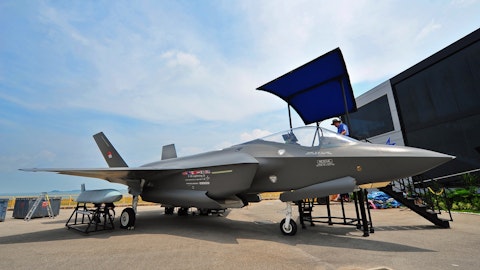Operator: We’ll move next to Cai von Rumohr at TD Cowen.
Cai von Rumohr: Yes, thank you very much, Phebe. Good, good numbers. So Gulfstream, two issues. First, you mentioned the Hamas attack and the impact on the G280. Maybe tell me the status of that and what that means in terms of your ability to get deliveries. And secondly, I think the bigger question is, by my quick math, it looks like your guidance for ’24 implies an 18% incremental margin at Gulfstream, which seems low given the good margins you should be getting on the G700.
Phebe Novakovic: Okay. Right. So look, let’s agree that we shouldn’t in any given moment infer something from an implied margin. I think as you know probably better than most that the margin performance in any given quarter is driven by a myriad of factors that we have gone over multiple, multiple times and I think in this environment where we are encouraged by the supply chain, but we’ve got more ways to go, we think that we have given you a very, very balanced plan and I really stick to that plan. That’s how I think about it. With respect to the G280, we have properly adjusted our plan to deal with the realities of what they are facing there. They are continuing to perform with retirees and management and as I say, we factored all of that into our expectations for the year.
Cai von Rumohr: So is that, I still don’t quite understand, the 18% margin, is that sort of a P&L drag, the fact that there’s — they can’t get enough or the timing?
Phebe Novakovic: I wouldn’t say it’s a P&L drag. It’s just a reality of the multiplicity of factors that are impacting us. ’24 is a pivotal year. We saw a significant improvement in the supply chain during the course of the year that frankly allowed us to increase production in the latter half of the year. If you recall, we were delivering between 24 aircraft and 25 aircraft and we delivered 39 aircraft in the fourth quarter. That makes us pretty optimistic that we can continue to increase production, but we are cautious about the ability of the supply chain to keep up. All indicators are that they’re doing quite well, but this is one step at a time and there’s more risk. As I say, we’re optimistic, but we’ve got a ways to go.
Operator: We’ll move next to George Shapiro at Shapiro Research.
George Shapiro: Just following up a bit on Cai’s question, the incremental margin was like 38% here in this fourth quarter, which is pretty extraordinary. So, what changes to really knock that down to the point that Cai’s comment?
Phebe Novakovic: Hey, you guys are reverse engineering incremental margin and it’s almost impossible to deal with in the complexity of this business. I would infer nothing from it. Look, let’s talk about the underlying capabilities. Gulfstream has a lot of operating leverage. They’ve always been a good since we acquired them at GD years ago. They have been strong operating performers, with very good margin performance and gross margins coming out of their operations. That won’t change, but the mix of business, the level of any given quarters, timing around supply chain and its impact on out-of-station work and mix of service, jet aviation, all of those things are contributing. So, there is nothing systemic other than those issues that you know, and they are temporary and we will work through the supply chain issues, but there’s nothing systemic that should concern you about where we stand on Gulfstream and its ability to increase margins, earnings and revenue over time here.
George Shapiro: And one for you, Jason. The unbilled receivables were down like $450 million in the quarter. Is that just Ajax catching up?
Jason Aiken: It’s a little bit Ajax and it’s a little bit of the ongoing payments on our other large international program of combat systems. Those are the two big pieces. Yes, George.
Operator: We’ll take our next question from Robert Spingarn at Melius Research.
Robert Spingarn: Phoebe, Phebe the marine guide implies about $340 million in sales growth and in the past, you’ve talked about Columbia driving $400 million to $500 million of growth per year. So, could an economic price adjustment for Virginia-class be a meaningful source of sales and operating income for Marine in 2024?
Phebe Novakovic: Well, EPA adjustments can always be a good source of income. Look, I think the way that we’ve always talked about Marine growth being somewhat lumpy, $300 million to $500 million in any given year, but in the next two years, we expect between $600 million and $1 billion in per annum growth. So the growth is there. It just comes in on a lumpier basis than one might want, but it is there. So with respect to Virginia and any EPA adjustments, we’re continuing to work with the Navy. We had contemplated the impact of Columbia prioritization, as had the Navy, on Virginia and that’s just a work in progress as we work through all the particulars with the Navy, but we think we’ve given you a pretty good indicator of this year’s revenue and we’ll adjust it accordingly if anything changes on the upside.
Robert Spingarn: So just to be clear, there’s nothing in there for an adjustment yet?
Phebe Novakovic: No. I think it’s premature to put numbers in before you’ve got an agreement with your customers.
Robert Spingarn: Fair enough. Thank you.
Phebe Novakovic: And Audra, I think we have time for just one more question.
Operator: Thank you. We’ll take that question from Peter Arment at Baird.





